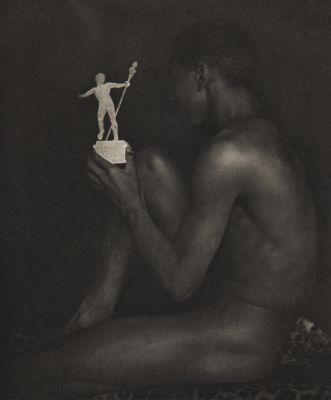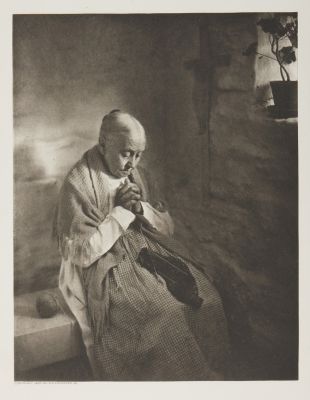
Title
SpringArtist
White, Clarence H. (American, 1871-1925)Publication
American Pictorial Photography, Series OneDate
1899Process
PhotogravureAtelier
Photochrome Engraving Company, New YorkImage Size
13.7 x 12.5 cmSheet Size
38 x 28 cm
"One of the masterpieces of American photography." Sadakichi Hartmann 1900
Among the most complicated and successful of the tipped-in photogravures in Camera Notes was Clarence H. White’s "Spring". White’s classically inspired triptych was the only photogravure in Camera Notes printed on tissue-weight paper, a fragile stock Stieglitz later used extensively in Camera Work. Seen through multiple cut-out sections of a well-chosen gray-green paper, "Spring" is a delicate interpretation of the pictorial spirit in photography.
Coincidentally it was in portfolio form that the photogravures of Camera Notes best attained stature as independent works of art. While the journal’s gravure plates were always beautifully presented and greatly admired, they, nonetheless, remained a part of a larger whole – an issue of a magazine. Fully aware of this containerization, Stieglitz undertook two portfolio projects with Camera Notes gravures to further legitimize their artistic value. And, once again, he simultaneously promoted photography as a form of art and photogravure as a means of original image making. Published in 1899 and 1901 by Stieglitz’s publications committee of the Camera Club of New York, each portfolio contained eighteen photogravures, almost exclusively printed from the same plates used for Camera Notes. Titled America Pictorial Photography, ””Series I", and "Series II", they focused on what Stieglitz considered the best work being produced by creative photographers living in the United States. Those workers who were heavily represented in Camera Notes were also prominent in the portfolios: Berg, Day, Eickemeyer, Eugene, Kasebier, and Stieglitz.
According to Joseph T. Keiley, the purpose of the portfolios was to make available at a modest price examples of this country’s most accomplished pictorial work. It is curious, however, that the targeted audience for the portfolios was the membership of the camera club itself, for all but three of the thirty-six photogravures contained in the two portfolios had or would also appear in Camera Notes, which every member received. What Stieglitz was doing here was asserting that the photogravures of Camera Notes were, in fact, worthy of individual contemplation as artistic objects in their own right. By providing portfolios of loose gravure plates he both promoted the value of Camera Notes as a whole and made it possible for single images to be framed and exhibited without dismantling issues of the magazine.
Features of the portfolios themselves pointed to the significant and collectible nature of the plates. Both sets were strictly limited to a numbered edition of one hundred fifty copies, most of which were subscribed to before publication. Subscribers were personally honored by having their name printed in their own copy, and each portfolio was signed by Stieglitz. A well-designed title page and table of contents, handsomely printed in red and black, accompanied the plates, all of which were enclosed in a green cloth-covered case stamped in gold with the seal of the Camera Club of New York.
Of course, the photogravures themselves attracted the most attention. Printed either on transparent tissue or heavy stock, these gravures mimicked their counterparts in Camera Notes in both size and color. Many of them were trimmed and mounted on carefully chosen colored papers, like only a few of the photogravures in Camera Notes. These paper mounts were almost twice the size of the pages in Camera Notes, giving the portfolio gravures a great deal of breathing room and endowing them with a rarified sensibility. So good was the printing and so effective was the presentation that reviewers compared the photogravures from the portfolios to actual photographic prints. Keiley found them "so remarkably executed as to deceive the eye into the belief that they are original platinum and carbon prints and not merely reproductions therefrom." And London’s Amateur Photographer stated: "In those cases in which the print has been trimmed and mounted on a tinted sheet, it is not easy to tell whether it is a photo-etched reproduction or a platinum print, so faithfully have the subtle qualities of the original been preserved."
"The Photogravure Process and Precedents for Camera Notes" By Christian Peterson
Reproduced / Exhibited
Stieglitz, Alfred, Richard Whelan, and Sarah Greenough. Stieglitz on Photography: His Selected Essays and Notes. New York, NY: Aperture Foundation, 2000. p. 130
References
Peterson, Christian A. Alfred Stieglitz’s Camera Notes. Minneapolis: Minneapolis Institute of Arts, 1993
Jussim, Estelle “Technology or Aesthetics: Alfred Stieglitz and Photogravure,” History of Photography 3, no. 1 (January 1979)



